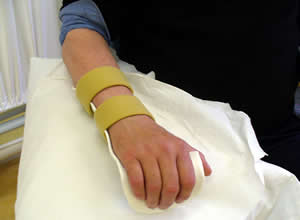Why would splinting be used?
- May reduce pain (by providing support to joints)

- May reduce deterioration from spasticity
- May prevent contracture
- May increase range of movement
- May block unwanted movement
- May improve function
- May improve hand hygiene
Caution: Hand splinting alone will not improve upper limb function or reduce tone. It is a valuable adjunct to other management interventions such as physiotherapy, spasticity management etc. It is therefore important that there is careful consideration for the rationale for selecting this intervention.
Alan has been provided with a custom made hand splint by the therapist. Splint application can be effective if there is good team working. Drag the possible solutions to match the potential issues that may occur.
Alan has been provided with a custom made hand splint by the therapist. Splint application can be effective if there is good team working. Drag the possible solutions to match the potential issues that may occur.
| Why splints may not always be successful | How to optimise the use of splints | |
| 1 | Doesn’t hold the position and is difficult to apply | The splint is appropriate for the situation it is required for, is a good fit and therefore easy to apply. |
| 2 | No one quite sure of what its for or when to apply it | Good and clear communication and education of patient, carers and staff. Documented procedure. |
| 3 | Uncomfortable/skin breakdown | All staff are responsible for monitoring pressure areas and there is a structured programme of application with clear guidance. |
| 4 | Nobody is sure who is responsible for its application, review or revaluation of its outcome | All staff know who is responsible for its provision. The splint is regularly reviewed and re-evaluated. |
| 5 | The patient is not motivated to use the splint and keeps taking it off | A full explanation of the rationale behind its use and what is required from the patient is provided and the patient gives informed consent to the provision of a splint. |
| 6 | The patient finds it painful and can only wear it for a short time | There is a structured programme to gradually increase the time the splint is worn. The splint may be causing too big a stretch. Using serial splinting to slowly gain the optimum position may reduce discomfort. |
Page last reviewed: 27 May 2021


